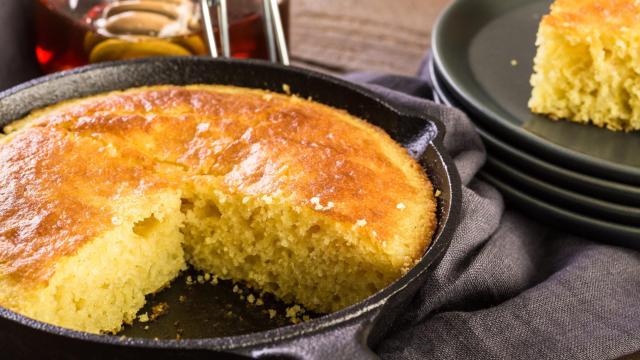Few dishes are as political and polarising as cornbread. If you think the pineapple on pizza debate is heated, whoo boy, ask someone from the American South if cornbread should be sweet or savoury. Much like the great Sugar in Grits debate, the topic of cornbread often elicits a visceral reaction, especially among Black people.
You see, corn was one of the few crops that the enslaved recognised when they were forced to work on New World plantations. Though its domestication goes back 10,000 years to Southern Mexico, the general historical consensus is that the Portuguese introduced corn to Africa in the 16th century. West Africans knew how to manipulate corn kernels and create delicious dishes — especially baked products — all without milk, butter, and eggs. The original American cornbread recipe calls for cornmeal, salt, hot water, and lard. That’s it.
According to food historian and author Michael Twitty, “[w]hat we call cornbread today, puffy and leavened with egg, was corn [once] pone. It originated with British colonists who adapted their baking to meal ground from white corn.” In Jamaica, where I am from, corn pone is a dense dessert made with yellow cornmeal and redolent with nutmeg, cinnamon, and allspice. It takes a skilled hand to ensure that it doesn’t come out as solid as a brick. There’s an old-timey Jamaican saying: “A bad pone can kill a pig.”
As Juneteenth is upon us in the US, I’ve been having heaps of conversations about cornbread — its origins, transformation, and meaning. For African-Americans, cornbread represents an intuitive desire to see themselves reflected within the pantheon of American cuisine. We all love fried chicken and know its origins, but somewhere along the line, cornbread was appropriated and its origin story muddled. Cornbread is American, more so than apple pie. Want proof? The Southern Foodways Alliance chose Cornbread Nation as the title of their anthology of Southern food writing.
In the kitchens of the Big House, making cornbread allowed enslaved cooks to transport themselves home. As the cornmeal flowed through their fingers while they measured the ground meal, memories of the middle passage were shifted, momentarily, to the back burner. The flowing yellow or white meal reminded them of kenkey, pap, ungali, and mealie bread — dishes made from ground corn that they’d eat back home.
In Texas, the birthplace of Juneteeth, cornbread has long been revered. An 1853 New York Times article — published 12 years before Juneteenth — about Texas proclaimed, “cornbread forms the staple article of diet — anything composed of wheat flour being about as scarce as ice-cream in Sahara.” There are many different types of cornmeal on the market, and I’ve tried most of them. Texans prefer skillet cornbread to the corn muffins you’d find in, say, South Carolina, and I prefer cornbread made with finely-milled cornmeal. Although coarse-ground meal offers a better crumb, I like a cornbread that I can scoff down without the need for a beverage. (I don’t like for my cornbread to eat like a Popeyes’ biscuit.) If you like Jiffy, good for you, so do I.
I see cornbread as a palantír — mystical and indestructible — representing what was, and a forecast of our future. As divisive as it is, it also brings us together, especially when you’re mocking how someone else makes theirs. My aunt puts cream-style corn in hers. I put cubes of cheddar and flecks of Scotch bonnet pepper in mine. I’ve seen Caribbean chefs add orange zest and coconut, and I’ve seen chefs in the American South use whole kernel corn and bacon in their mixture. Whichever way you slice it, cornbread is freedom manifested in one delicious bite after another.
Here’s my go-to recipe for cast-iron skillet cornbread that I make time and time again. Sugar is optional.
How to make cast-iron skillet cornbread
Ingredients
- 1 1/2 cups ground cornmeal (Ensure it’s not corn flour! Please don’t make that mistake. When in doubt, pick medium or coarse grain)
- 3/4 cup self-rising flour (Keep the side-eye to yourself, self-rising is a gem!)
- 1 ¼ cups buttermilk
- 2 tablespoons hot water
- 1 stick of butter, melted; plus a quarter of a stick, unmelted
- 2 eggs, beaten
- 1 300 g can whole kernel corn, drained
- ½ cup white sugar (Yes, it’s optional)
Place cast-iron skillet in oven and preheat to 200C. In a bowl, mix melted butter, buttermilk, eggs, and sugar if you care for it. In a separate bowl, combine the cornmeal and flour. Make a well in the centre of the dry ingredients and add the wet ingredients, then mix using a wooden spoon. Add corn and hot water and incorporate. Take the hot skillet out the oven and drop in the knob of butter (¼ stick). When it melts, add the cornbread mixture. It should sizzle. Place in oven and bake for 30 minutes or when a knife inserted in the centre comes out clean.

Leave a Reply
You must be logged in to post a comment.